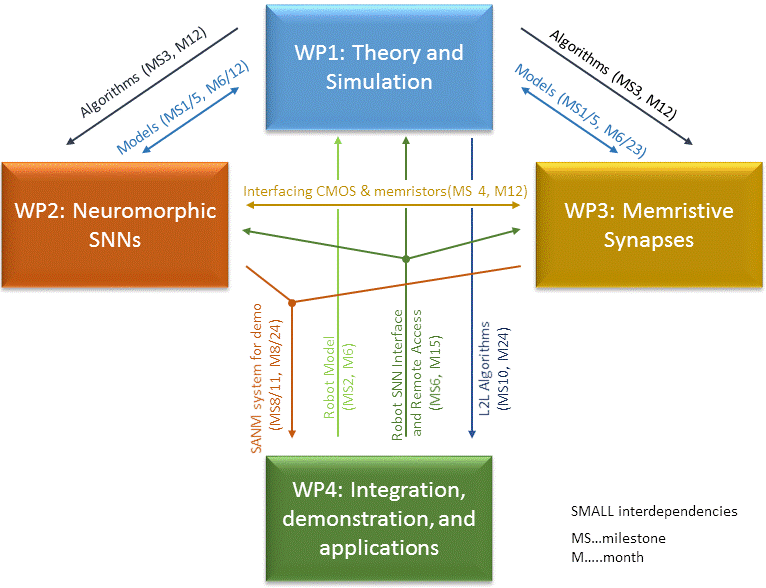Spiking Memristive Architectures for Learning to Learn
Contemporary AI applications often rely on deep learning, which implies heavy computational loads with current technology. However, there is a growing demand for low-power autonomously learning AI systems that are employed “in the field”. We will investigate in this project options for learning in low-power unconventional hardware that is based on spiking neural networks (SNNs) implemented in analog neuromorphic hardware combined with nano-scale memristive synaptic devices. Hence, the envisioned computational paradigm combines the three most promising avenues for minimizing energy consumption in hardware:
- analog neuromorphic computation,
- spike-based communication, and
- memristive analog memory.
Experts in each of these fields will collaborate on the development of a functional prototype system. We will in particular consider recurrent SNNs (RSNNs) as their internal recurrent dynamics render them more suitable for real-world AI applications that have temporal input and demand some form of short-term memory. We will adapt a recently developed training algorithm such that it can be used to optimize SNNs in neuromorphic hardware with memristive synapses. “In the field” applications often demand online adaptation of such systems, which often necessitates hardware-averse training procedure.
To overcome this problem, we will investigate the applicability of “learning to learn” (L2L) to spiking memristive neuromorphic hardware. In an initial optimization, the hardware is trained to become a good learner for the target application. Here, arbitrarily complex learning algorithms can be used on a host system with the hardware “in the loop”. In the application itself, simpler algorithms – that can be easily implemented in neuromorphic hardware – provide adaptation of the hardware RSNNs.
In summary, the goal of this project is to build versatile and adaptive low-power small size neuromorphic AI machinery based on SNNs with memristive synapses using L2L. We will deliver an experimental system in a real-world robotics environment to provide a proof of concept. The ED-Scorbot is being used as test-bed (http://www.rtc.us.es/ed-scorbot/).

Consortium:
- Coordinator: TU-Graz – AU (https://www.tugraz.at/institute/igi/home/)
- Partners: INI/UZH – SW (https://www.ini.uzh.ch/), SOTON – UK (https://zepler.soton.ac.uk/), IBM – SW (https://www.zurich.ibm.com/st/neuromorphic/), RTC – ES (http://www.rtc.us.es/)
PI: Alejandro Linares Barranco
Programa EU: CHIST-ERA 2018: https://www.chistera.eu/projects-call-2018
Reference: PCI2019-111841-2
Funding by: Ministerio de Economía y Competitividad
Start date: 01-01-2020
End date: 31-12-2023
Researchers:
- Claudio Amaya Rodríguez
- Daniel Cagigas Muñiz
- Daniel Cascado Caballero
- Antón Civit Balcells
- Fernando Díaz del Río
- Juan Pedro Domínguez Morales
- Manuel Jesús Domínguez Morales
- Francisco Gómez Rodríguez
- Daniel Gutiérrez Galán
- Angel Jiménez Fernández
- Gabriel Jiménez Moreno
- Fernando Pérez Peña
- Enrique Piñero Fuentes
- Antonio Ríos Navarro
- Saturnino Vicente Díaz

